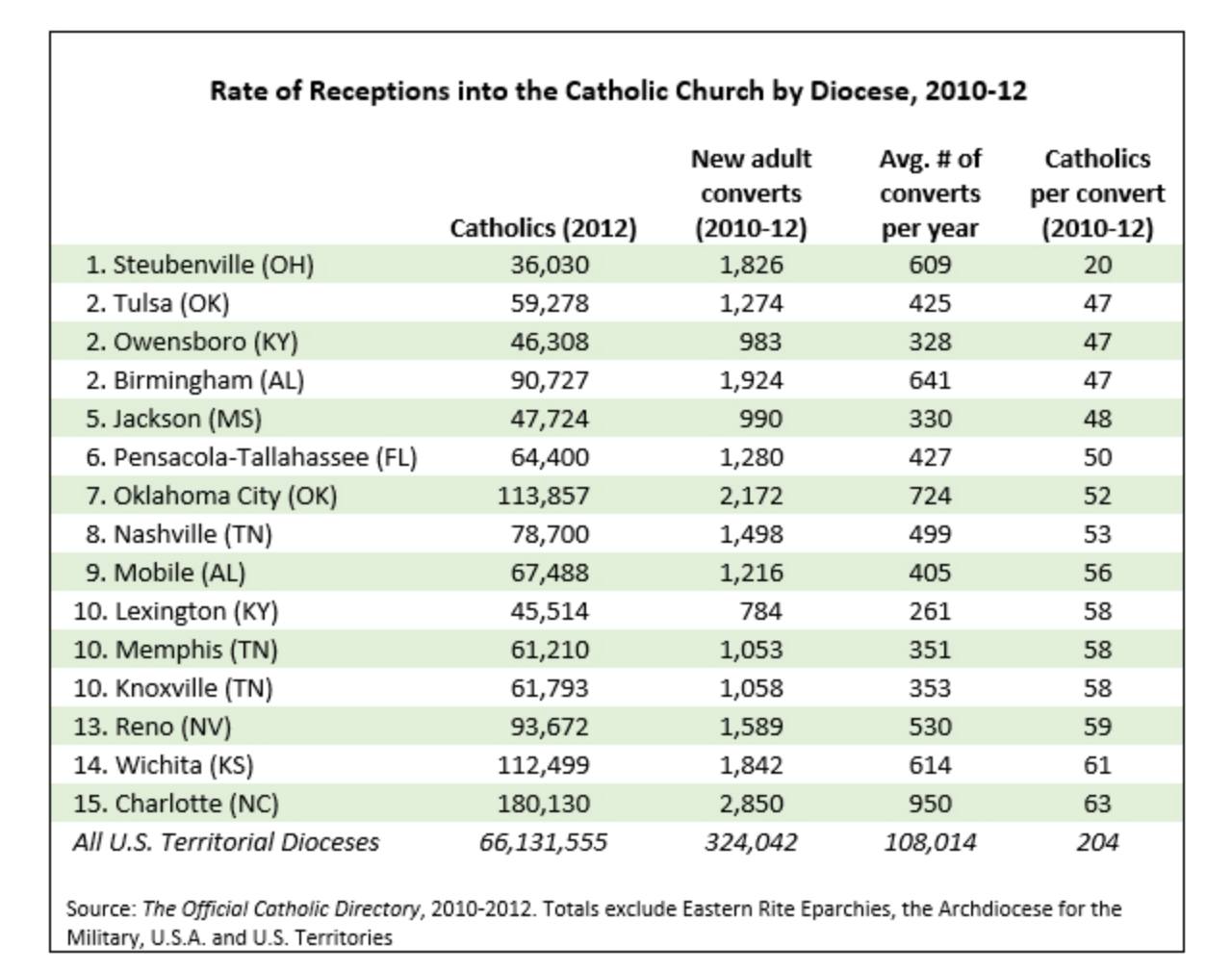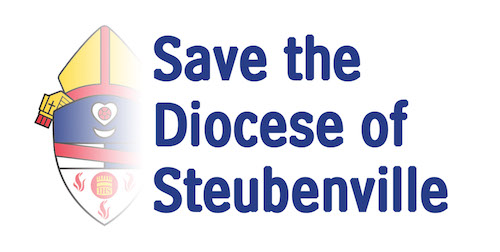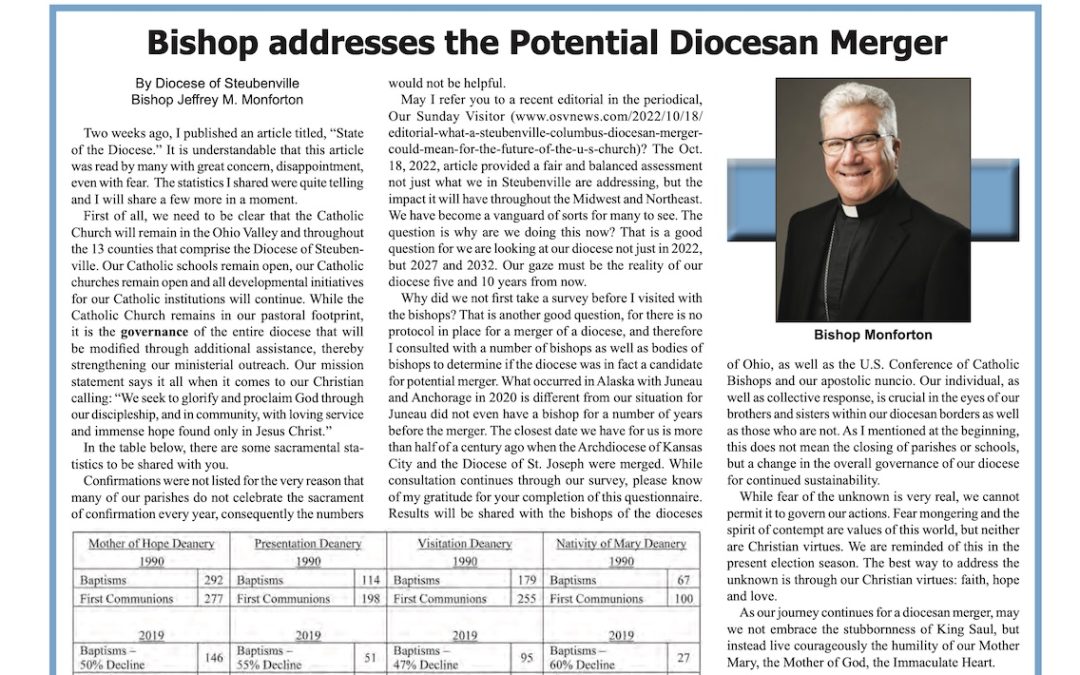He fails to do so, and in the process shows a level of contempt for his faithful — which is ironic, ultimately. More on that in a moment.
A classic “fisking” seemed the only approach. So here is His Excellency’s text (which isn’t long) with my replies and commentary in breaks.
Two weeks ago, I published an article titled, “State of the Diocese.” It is understandable that this article was read by many with great concern, disappointment, even with fear. The statistics I shared were quite telling and I will share a few more in a moment.
The statistics he shared do not fairly represent the status of the Diocese, as I and others have explained. See my previous posts for more. (here also)
First of all, we need to be clear that the Catholic Church will remain in the Ohio Valley and throughout the 13 counties that comprise the Diocese of Steubenville. Our Catholic schools remain open, our Catholic churches remain open and all developmental initiatives for our Catholic institutions will continue.
He cannot promise this. By abandoning his post as bishop and giving absolute control of the Church in these 13 counties over to another bishop he is giving total authority to that bishop. The reality is, since the rest of the Diocese of Columbus has a more severe priest shortage than Steubenville the numbers will eventually dictate that our priests are moved and (most likely) parishes are merged and perhaps closed.
While the Catholic Church remains in our pastoral footprint, it is the governance of the entire diocese that will be modified through additional assistance, thereby strengthening our ministerial outreach. Our mission statement says it all when it comes to our Christian calling: “We seek to glorify and proclaim God through our discipleship, and in community, with loving service and immense hope found only in Jesus Christ.”
Again: this is just baffling. As soon as the Diocese of Steubenville ceases to exist, this mission statement means nothing. The bishop of Columbus will have all authority to make those decisions. We have no reason to believe that the bishop of Columbus will flood the zone with cash for ministerial outreach, and if he does, we have no reason to believe the programs will actually help.
Indeed, according to the 2012 CARA Report, Steubenville led the nation during the period 2010-12 in new converts entering the Church.

Bishop Monforton has cited statistics comparing Diocesan numbers from 1990 to 2020 to show a dramatic decline in various metrics in that 30-year span. Well, here is a stat from closer to now than then, and it looks really good.
Further, as has been pointed out elsewhere, the Diocese of Steubenville has about as many overall people (Catholic and non) in it now as it did in 1950 (497,000 to 503,000), and among our Catholics, more than half attend Mass weekly — that is among the best rates in the country. Our numbers are not bad.
In the table below, there are some sacramental statistics to be shared with you. [I put the table at the bottom of this post]
Confirmations were not listed for the very reason that many of our parishes do not celebrate the sacrament of confirmation every year, consequently the numbers would not be helpful.
May I refer you to a recent editorial in the periodical, Our Sunday Visitor (www.osvnews.com/2022/10/18/ editorial-what-a-steubenville-columbus-diocesan-merger- could-mean-for-the-future-of-the-u-s-church)? The Oct. 18, 2022, article provided a fair and balanced assessment not just what we in Steubenville are addressing, but the impact it will have throughout the Midwest and Northeast. We have become a vanguard of sorts for many to see.
I weep for anyone who sees this model of a “listening Church” acting responsibly or being synodal and thinks it is a model to emulate.
I already wrote about that unfortunate editorial. It is not fair and balanced, in large part because it gets so much wrong, and wrongly extrapolates our experience to other dioceses in the Midwest and Northeast.
The question is why are we doing this now? That is a good question for we are looking at our diocese not just in 2022, but 2027 and 2032. Our gaze must be the reality of our diocese five and 10 years from now.
With respect to His Excellency, that is precisely what I and many others are doing, and we see great signs for great hope. As His Excellency notes at the end of the article, hope is a Christian virtue.
The fact is, neither Bishop Monforton nor I nor anyone else can know the “reality of our diocese five and 10 [sic] years from now.” We can both look at indicators, consider factors, and make a prediction. Bishop Monforton believes the future is so bleak that suppression and merger is the only way forward. I and many others look at the available numbers and see greater indicators of good things to come.
Why did we not first take a survey before I visited with the bishops? That is another good question, for there is no protocol in place for a merger of a diocese, and therefore I consulted with a number of bishops as well as bodies of bishops to determine if the diocese was in fact a candidate for potential merger.
Whither a consultation with the priests and faithful? If there is no protocol, there was nothing barring that consultation. In an age of synodality and “listening Church” it seems error should be on the other side.
What occurred in Alaska with Juneau and Anchorage in 2020 is different from our situation for Juneau did not even have a bishop for a number of years before the merger.
WELL THEN! This means that Juneau was in even worse shape than we are right now. And even Juneau retained its co-cathedral.
The closest date we have for us is more than half of a century ago when the Archdiocese of Kansas City and the Diocese of St. Joseph were merged. [Again, as explained elsewhere, this isn’t a good comparison] While consultation continues through our survey, please know of my gratitude for your completion of this questionnaire. Results will be shared with the bishops of the dioceses of Ohio, as well as the U.S. Conference of Catholic Bishops and our apostolic nuncio. Our individual, as well as collective response, is crucial in the eyes of our brothers and sisters within our diocesan borders as well as those who are not.
So, again, take that survey, as well as the better one, but be sure to voice your entire opinion — with respect! — in the spaces available for text.
As I mentioned at the beginning, this does not mean the closing of parishes or schools, but a change in the overall governance of our diocese for continued sustainability.
HE CANNOT PROMISE THIS. He can say it doesn’t *mean* any closures, but he cannot *promise* that this will not happen more or less as a result of the merger. And, again, given the priest shortage in Columbus, closures and mergers in parishes is highly likely as a result.
While fear of the unknown is very real, we cannot permit it to govern our actions. Fear mongering and the spirit of contempt are values of this world, but neither are Christian virtues. We are reminded of this in the present election season. The best way to address the unknown is through our Christian virtues: faith, hope and love.
As our journey continues for a diocesan merger, may we not embrace the stubbornness of King Saul, but instead live courageously the humility of our Mother Mary, the Mother of God, the Immaculate Heart.
Oh come now.
I’ll just leave my reply to those two paragraphs at that, and close with a call for prayer for Bishop Monforton, for all bishops who have to deal with this matter, and for the Holy Spirit’s guidance of all.
Table of Statistics Included In the Article


